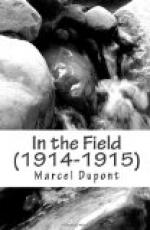Just as I came to the hall Sister Gabrielle also arrived, with a small lantern in her hand. I must have frightened her, for she started and gave a little scream. But she soon recovered, and guessed what had disturbed me. She told me all about it in a few simple sentences; a poor woman had fled from her village, carrying her little girl of eighteen months. As she was running distractedly along the road from Lizerne to Boesinghe a German shell had fallen, and a fragment of it had killed her baby in her arms. She had just come six kilometres in the dark, clasping the little corpse to her breast in an agony of despair. She got to Elverdinghe, and knocked at the door of the convent, knowing that there she would find a refuge. And all along the road she had passed convoys, relief troops and despatch-riders; but she took no heed of them; she was obsessed by one thought; to find a shelter for the remains of what had been the joy and hope of her life.
“Just come,” said Sister Gabrielle. “I will let you see her. We have put the poor little body in the mortuary chamber, and Sister Elizabeth is watching there.”
I followed Sister Gabrielle, who opened a small door, and went down a few steps; we crossed a paved court. Her lantern and my candle cast yellowish gleams upon the high walls of the buildings. Heavy drops of rain were falling, making a strange noise on the stones. And a kind of anguish seized me when I again heard the continuous wailing of the unhappy mother. Sister Gabrielle opened a low door very gently, and we went in.
I must confess that I had been much less moved when, after the first day of the Battle of the Marne, we passed through a wood where our artillery had reduced a whole German regiment to a shapeless mass of human fragments. Here I realised all the horror of war. That men should kill each other in defence of their homes is conceivable enough, and I honour those who fall. But it passes all understanding why the massacre should include these poor weak and innocent creatures. And sights such as the one I saw in that little mortuary chapel inspire a fierce thirst for vengeance.
On a kind of large table, covered with a white cloth, the poor body was laid out. It bore no trace of any wound, and the little white face seemed to be smiling. The good nuns had covered the shabby clothes with an embroidered cloth. Upon that they had crossed the little hands, which seemed to be clasping a tiny crucifix. And over the whole they had strewn an armful of flowers. On each side they had placed silver candlesticks, and the reddish candle-light made golden reflections in the curly locks of the little corpse. Crouching on the ground by the side of it, I saw a shapeless heap of clothes which seemed to be shaken by convulsive spasms. It was from this heap that the monotonous wailing came. It was the young mother, weeping for her little one. One felt that nothing could console her, and that words would only increase her suffering. Besides, she had not even raised her head when we went in. It was best to leave her alone, since they say that tears bring comfort.




